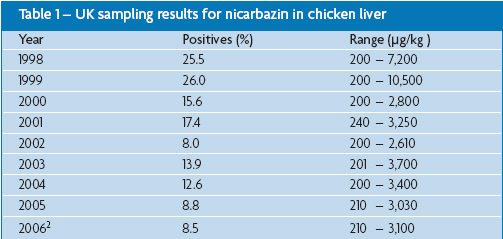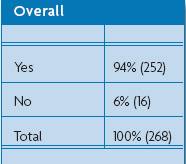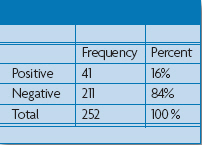



Reducing Nicarbazin Levels in British Chicken
Chicken farmers need to devise a system to ensure that feed bins are thoroughly cleaned out and feed is replaced five days before harvesting, to ensure that nicarbazin residues are removed from the birds, writes Chris Harris, Senior Editor, The Poultry Site.This was the major finding of a joint study by the British Food Standards Agency together with the British Poultry Council, the National Farmers Union and the Veterinary Medicines Directorate (VMD).
Nicarbazin is a feed additive used for the treatment of coccidiosis, a potentially fatal and debilitating disease of chickens.
It is available commercially as the feed additive Maxiban.
Research showed that although the incidence of residues has been falling and the industry has been working hard to reduce these residues, there was room for further improvement.
The aim of the work was to identify why residues are still being found in chicken and how they could be avoided. This would inform best practice advice about on-farm feed management practices that could be publicised to growers to help them avoid or at least reduce nicarbazin residues in their chickens.
The initiative covered poultry farmers in Great Britain, whose chickens were sampled for veterinary residues under the National Surveillance Scheme (NSS) for 2007, operated by the Veterinary Medicines Directorate.
Each year the VMD take samples from poultry slaughterhouses to test for nicarbazin as part of their National Surveillance Scheme for veterinary residues. Table 1 shows results from the NSS for nicarbazin in chicken liver from 1998 to 2007.

2 2007 results are not referred to in the report because the project overlapped the 2007 sampling period and may have had an influence on the percentage of positives.
Although the VMD says that the levels of nicarbazin currently found in poultry are low and not a food safety risk, the reports says that consumers expect residue levels to be kept to a minimum and they want assurances of the lowest possible concentrations of residues of feed additives.
At present there is no established EU Maximum Residue Limit (MRL) for residues of nicarbazin in poultry meat and liver. EU MRLs are currently being established for those coccidiostats that are licensed for use in the Community.
Globally, the WHO/FAO Joint Expert Committee on Food Additives (JECFA) has established an MRL for nicarbazin of 200 µg/kg in liver and this has been adopted by the UK as an unofficial regulatory limit.
When nicarbazin levels over 1000 µg/kg are found they are followed up on-farm by the Animal Medicines Inspectorate and/or Animal Health. The Animal Medicines Inspectorate (AMI) may also visit the feed mill if necessary.
However, the current study showed that these visits could be several months after the sampled birds were slaughtered, which made it difficult to get a true and accurate picture of feed management practices on the farm at the time the birds were being raised.
The latest survey took samples of chicken livers and muscle at slaughterhouses by the MHS.
Between 1 February last year and 31 January this year the farmers, who had their birds sampled, were also sent a questionnaire to complete, to find out the feed management practices on-farm.
The data collected was analysed by the Food Standards Agency.
Usage of Nicarbazin

A total of 320 questionnaires were sent to farms and 268 were returned (a high response rate of 86 per cent). Sixteen farms (six per cent) did not use nicarbazin, which left a final sample size of 252.
It was decided that detectable levels of nicarbazin should fall into three categories: levels less than 200µg/kg are not considered to be "positives" as they are below the JECFA MRL action level; low level positives between 200 and 1,000µg/kg which are notified to the farmers concerned by the VMD; and high level positives above 1,000µg/kg which are investigated with a farm visit.
In all 18 samples proved positive, where the residues were in excess of the 200µg/kg reference level (JECFA MRL) for nicarbazin and samples reported above the Limit of Detection (LOD). This maximised the number of samples for the analysis and optimised the chance of determining any trends in the data. As a result of this the positive sample size increased from 18 to 41 with levels ranging from 60 µg/kg - 3000µg/kg (only two samples were below 100µg/kg).
Final Screening Results
Residue above Level of Detection

The study found that there was no correlation between the farm type - fully integrated, housed, free range or organic - and those farms found with positive samples.
There was a slight increase in the number of positives, where feed was transferred between farms, but there was no increase in the incidence of residues from birds that had been thinned compared to those removed at final depopulation.
There was a slight increase in the incidence with birds eating from pans although the analysts said this was statistically insignificant.
However, the study did show there was a significant drop in nicarbazin residues where the birds scratched out the feed from the pans or tracks rather than directly feeding from them.
There was an increase in the positive group for farms not completely emptying single bins between delivery of nicarbazin feed and five days before processing. If the bins are not emptied of nicarbazin feed, according to the 'first in last out' principle, it may be fed to birds after the withdrawal rations and just before processing.
The study said that contrary to expectations there was an increase in farms that tested negative that claimed to have placed finisher feed on top of nicarbazin feed for double bins, while no farms that reported positive claimed to have placed withdrawal feed on top of another feed, five per cent of the farms that tested negative claimed to have placed withdrawal feed on top of another feed.
"Current best practice is that all farms using nicarbazin should ensure that bins are completely emptied between last nicarbazin delivery and five days prior to processing. In addition, withdrawal feed should not be placed on top of another feed," the report says.
The Food Standards Agency said that one of the main outcomes of the study is that this joint initiative provides a good example of industry and regulators working successfully together to overcome a problem which was first identified in the late 1990s and for which no easy solution was available. The joint working made it possible to overcome barriers which had previously prevented the issue from being investigated.
The report recommends:
- That the current best practice advice be maintained because it is still appropriate and has been successful in reducing nicarbazin residues;
- That all levels of farm staff be trained and that training be refreshed on a regular basis.
- That managers remove any existing blame culture to encourage mistakes to be identified and rectified quickly.
- That farm managers are aware of the precise amount of nicarbazin feed needed for the birds on the farm and which feeds contain nicarbazin.
- That farms devise a system (whether for a single or double bin) to make sure any bin that has received feed containing nicarbazin is completely emptied in the period between the last delivery of nicarbazin containing feed and five days before the first birds go for slaughter.
- That the feed in the feeders be tested regularly using the on-farm feed test (soon to be available) to confirm the robustness of the systems that farmers use to protect against nicarbazin residues in the poultry they produce.











